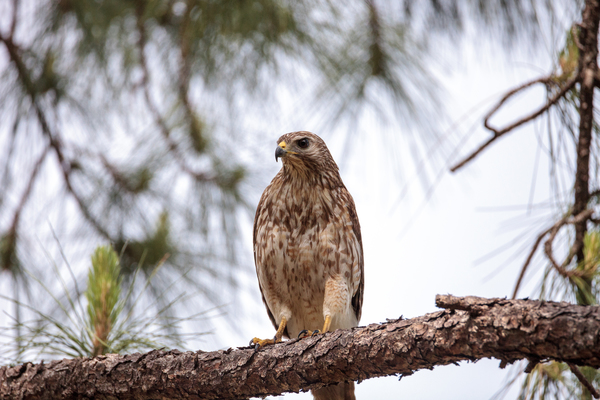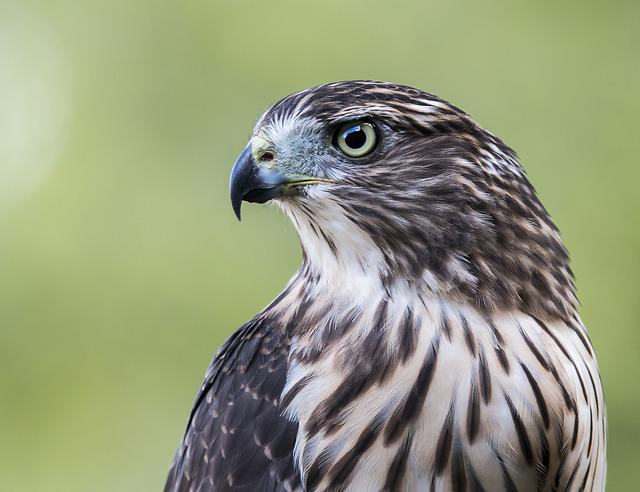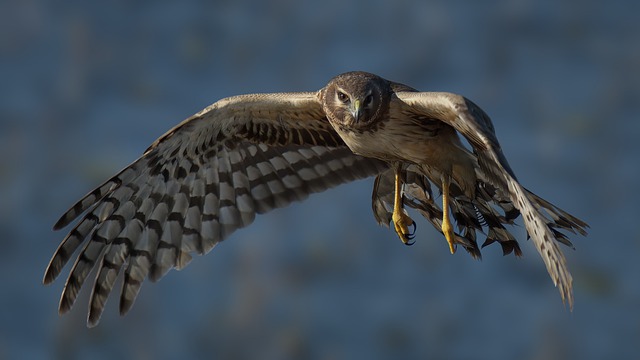Virginia is recognized for more than just mass tobacco cultivation. Tourists to the state can enjoy the state’s unique species of raptors, which may be seen swooping over the sky throughout the year.
Many birds of prey have made their way towards the state due to the 62% of the state, which is covered in forest areas, including bald eagles, peregrine falcons, hawks, and golden eagles.
There are eight different hawks in Virginia that visitors might not want to miss out on among all the types of birds that have adopted the state as their native habitat. Please take a look at them here!
| Image | Name |
|---|---|
 | Sharp-Shinned Hawk |
 | Northern Goshawk |
 | Broad-winged Hawk |
 | Red-Shouldered Hawk |
 | Cooper’s Hawk |
 | Rough-Legged Hawk |
 | Red-Tailed Hawk |
 | Northern Harrier |
Different Species of Hawks in Virginia
In Virginia, there are eight different types of hawks:
- Sharp-shinned Hawk
- Northern Goshawk
- Broad-winged Hawk
- Red-shouldered Hawk
- Cooper’s Hawk
- Rough-legged Hawk
- Red-tailed Hawk
- Northern Harrier
1. Sharp-Shinned Hawk

The Sharp-shinned Hawk could be seen all year round in northwest Virginia and even in the wintertime in southeast Virginia, despite being a migratory bird. They are uncommon, accounting for fewer than 3% of all bird observations in Virginia.
The Sharp-shinned Hawk is among Virginia’s tiniest hawks. They are somewhat bigger than crows but smaller than the Blue jay.
Females are one-third the size of males. They possess small, rounded wings, tiny heads, and lengthy tails with a round termination.
| Scientific Name | Accipiter striatus |
| Wingspan | 17 to 22 inches |
| Length | 87 to 218 g (9.5 to 13.5 inches) |
| Weight | 3 to 7.7 ounces |
Sharp-shinned adult Hawks have a reddish-orange chest and a blue-gray backside. Their tails feature black streaks around them.
They are quite elusive, however, they can be observed flying through open regions along the margins of woodlands. They are quite fast and can sprint through deep forests to capture their food in flight, which is mainly songbirds.
They are occasionally observed eating small birds nearby feeders, however, if you have a concern with them in the backyard, remove the feeders for several days.
Sharp-shinned prior to consuming their food, hawks pick it off a stump or low branch. They often prey on songbirds the size of robins.
Habitat
Sharp-shinned Hawk nests are commonly found in densely forested areas, mainly near the tops of towering trees. The nest is fairly huge, with a circumference of 1 to 2 feet and a depth of 4 to 6 inches.
They hatch 3 to 8 eggs that are white or pale blue speckled.
2. Northern Goshawk

Northern goshawks are one of the most difficult hawks to spot in several areas due to their elusive nature. However, since only hawks spend the winter in Virginia, it’s very difficult.
These hawks are related to Sharp-shinned and Cooper’s hawks and have a similar appearance. They are, however, more ferocious, and their bigger bodies assist them in attacking their prey.
| Scientific Name | Accipiter gentilis |
| Length | 16 to 27 inches (41 to 69 centimeters) |
| Wingspan | 35 to 50 inches (89 to 127 centimeters) |
| Weight | 22 to 50 ounces (630 to 1400 grams) |
The bodies of northern goshawks are grey, with red eyes and white stripes above their eyes. The three characteristics, particularly their audacious eyes, might assist you in identifying them from afar.
Furthermore, hawks have short, broad wings and long tails that aid them in chasing down their prey in fast motions. Please remember that if they feel intimidated, they may attack people as well, so know your limits.
Shrews, crows, foxes, chipmunks, rabbits, and geese are among the northern goshawk’s favorite meals.
They devour owls and kestrels as well, making them among the rare prey birds that eat other prey birds.
3. Broad-winged Hawk

Broad-winged Hawks mate in Virginia prior to flying to South America in enormous numbers in a whirling flock known as a kettle.
They are more common in the state’s western regions. They are uncommon in Virginia, appearing in only 1% of documented checklists on ebird.
The ideal time to observe them is during their migration in the autumn.
Broad-winged Hawk Hawks are small, stocky birds that are somewhere between a crow and a goose in size. Their heads are reddish-brown, their chests are barred, and their short rectangular tails are narrowly banded.
| Length | 13.4 to 17.3 inches (34 to 44 centimeters) |
| Wingspan | 31.9-39.4 inches (81 – 100 centimeters) |
| Weight | 265 to 560 grams (9.3 to 19.8 ounces) |
These hawks hunt small animals, frogs, snakes, and even juvenile turtles from a perch on the edge of woodlands or near water.
Broad-winged Hawk Hawks frequently lay 2 to 3 pale eggs in the nest of another species, including a squirrel or crow.
4. Red-Shouldered Hawk

Red-shouldered hawks have crimson shoulders & whitetails, as their name suggests. They’re quite colorful, which makes them simple to recognize after you get used to their form.
Another trait you can use to identify red-shouldered hawks is the transparent crescents on their wingtips which become noticeable when they’re soaring.
The red-shouldered hawks who spend the entire year in Virginia dwell in the state’s damp woodlands, with streams and creeks being their favorite habitats. You could come to see one perched atop a tree, where it’s most likely waiting to be seen by its food.
| Scientific Name | Buteo lineatus |
| Length | 17 to 24 inches |
| Wingspan | 37 – 43.5 inches |
| Weight | 17 – 27.3 ounces |
Red-shouldered hawks become upset when crows are present. These animals don’t get together and frequently take food from one another; you’d be lucky to see a battle between them.
Red-shouldered hawks are difficult to feed at bird feeders because they only eat amphibians, birds, reptiles, and small animals. They might, however, pursue the songbirds in the backyard.
If you see them, remove the feeder for several days, so there aren’t any bird tragedies on your watch!
5. Cooper’s Hawk

Cooper’s hawks are known for their keen hunting abilities. Pigeons and tiny hawks are among the many birds they feed on.
Sharp-shinned hawks and these types of hawks have very identical shapes. At first look, you’ll be puzzled, particularly when they both fly in almost the same flapping-gliding pattern.
Cooper’s hawks have a greater size and broader wings, which is the only way to tell them apart.
Cooper’s hawks feature long tails, which aid in their exceptional flying abilities. They spend the majority of their time flying through woodlands in pursuit of tiny birds and rodents.
Male
| Length | 14.6 to 15.3 inches (37 to 39 centimeters) |
| Wingspan | 24.4 to 35.4 inches (62 to 90 centimeters) |
| Weight | 7.8 – 14.5 ounces (220-410 grams) |
Female
| Length | 16.5 to 17.7 inches (42 to 45 centimeters) |
| Wingspan | 29.5 to 35.4 inches (75 to 90 centimeters) |
| Weight | 11.6 to 24.0 ounces (330 to 680 grams) |
Year-round hawks in Virginia are noted to approach backyard feeders occasionally in quest of songbirds to feed on. The most prevalent location for them is on the margins of woodlands. Cooper’s hawks like to stay away from congested areas.
Despite this, they’re growing increasingly popular in suburbs and urban areas, where they may hunt a large number of birds. You could come upon one of these while casually strolling along the road.
6. Rough-Legged Hawk

The plumes that coat their entire body and flow down their legs to their sharp nails are known as rough-legged hawks.
While this anatomical feature may give them a scary appearance, it aids birdwatchers in identifying these hawks because just three North American raptors have it. It also helps them warm when they’re reproducing in the chilly northern weather.
Rough-legged hawks are difficult to spot in Virginia since they only visit during the winter months, even when they’re not reproducing.
When summer arrives, the hawks fly to the northern tundra to hunt, lay eggs, and then return when the weather becomes too freezing for their kids. They don’t just move to Virginia; they also expand to Iowa, Idaho, and a few other states in the United States.
| Scientific Name | Buteo lagopus |
| Length | 18.5 to 23.5 inches (46 to 59 centimeters) |
| Wingspan | 52 to 54 inches (132 to 138 centimeters) |
| Weight | 25 to 49 ounces (715 to 1400 grams) |
Because they have the same buteo characteristics as red-tailed hawks, these hawks have a strong resemblance. Their large, thin wings let them glide over the land while hunting for food.
Rough-legged buzzards typically possess black bodies, however, bright morphs are possible. Because they have completely feathered legs, they might well be mistaken for ferruginous hawks.
The black tip on the rough-legged species’ tail, on the other hand, clearly distinguishes them.
7. Red-Tailed Hawk

Everyone who lives in North America has most likely seen red-tailed hawks. They’re one of the most prevalent hawks in the area and may be found in significant numbers all around the country.
Whether you see a hawk, check to see if it’s a red-tailed hawk; that’s most probably one. They’re abundant in Virginia, so you’ll almost certainly see one.
These hawks are year-round residents of the state. They spend much of their time perched on telephone poles — and any other lofty point, for that matter — trying to spot prey wandering nearby.
If you pay close attention to your regular commute, you’ll almost certainly see them. They enjoy remaining up high to keep an eye out for food on the land surface, such as reptiles and other animals.
Male
| Length | 17.7 to 22.1 inches (45 to 56 centimeters) |
| Wingspan | 44.9 to 52.4 inches (114 to 133 centimeters) |
| Weight | 24.3 to 45.9 ounces (690 to 1300 grams) |
Female
| Length | 19.7 to 25.6 inches (50 to 65 centimeters) |
| Wingspan | 44.9 to 52.4 inches (114 to 133 centimeters) |
| Weight | 31.8 to 51.5 ounces (900 – 1460 grams) |
The lower parts of red-tailed hawks are white with reddish-brown streaks. Their tails appear red, as befits their nickname, and they’re short, wide, and curved, as are all buteo hawks’ tails.
Do you recognize the classic shriek used in pictures to suggest the appearance of a hawk? The red-tailed hawk is the bird in the picture. Its shriek is so distinctive that it has become the standard accent in Hollywood films and television shows.
8. Northern Harrier

In North America, the northern harrier has been the sole subspecies. They’re tourists visiting the Mother of States for the winter.
The Arctic Tundra, an open-country environment north of the arctic circle, is where the majority of northern harriers mate. They like marshes and grassland in Virginia, which are comparable to their northern habitat.
Like owls, Northern Harriers possess facial disks (a circular pattern of plumage on the hawk’s face) to improve hearing.
They hover low over wetlands, like several other owls, to optimize this, depending mostly on their hearing to target prey, unlike some of the other hawks.
| Length | 18.1 to 19.7 inches (46 to 50 centimeters) |
| Wingspan | 40.2 to 46.5 inches (102 to 118 centimeters) |
| Weight | 10.6 to 26.5 ounces (300 to 750 grams) |
The hybrid hawk/owl appearance of the northern harrier makes it easy to spot. Their bottom has a white patch that sticks out.
Adult northern harriers get a characteristic pail gray appearance, giving them the nickname “Gray Ghosts.”
The cry of northern harrier hawks in Virginia might also be instructive. It’s not the frightful tone that most hawks make. A continuous high-pitched “kek” sound is played for around two seconds in a row. It feels like you’re at sea.
Conclusion
Virginia is home to a wide range of hawks; if you’ve not seen one yet, a trip to this region will provide lots of opportunities. Furthermore, the several species of raptors found here exhibit characteristics that are not found anyplace else.
The excitement of hearing the famous raptor shriek you’ve been searching for is unrivaled while searching for hawks. We wish you luck in your birding adventures!
FAQ
What Hawks Can You Find In Virginia?
As I previously stated, Virginia is home to eight (8) distinct species of hawks. Such as :
- Sharp-shinned Hawk
- Northern Goshawk
- Broad-winged Hawk
- Red-shouldered Hawk
- Cooper’s Hawk
- Rough-legged Hawk
- Red-tailed Hawk
- Northern Harrier
In Virginia, is it legal to kill a hawk?
Hawks are safeguarded by state and federal regulations in Virginia. Killing one, even though it was causing damage to your property, will be a crime.
If hawks get to be a problem, you could only harm them with permission from Wildlife Management.
Last Updated on March 22, 2023 by Lily Aldrin
